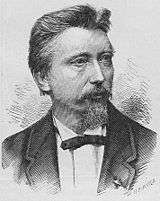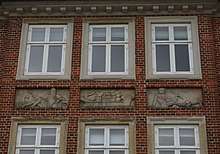Nyhavn 63
| Nyhavn 63 | |
|---|---|
.jpg) The house seen from the other side of the canal | |
| General information | |
| Location | Copenhagen, Denmark |
| Coordinates | 55°40′46.77″N 12°35′33.17″E / 55.6796583°N 12.5925472°ECoordinates: 55°40′46.77″N 12°35′33.17″E / 55.6796583°N 12.5925472°E |
| Completed | 1756 |
Nyhavn 15 is a historic townhouse overlooking the Nyhavn Canal in central Vopenhagen, Denmark. The building is listed on the Danish Registry of Protected Buildings and Places. A warehouse in the courtyard has been converted into a hostel.
History

Nyhavn 63 was built in 1756 for timber merchant Jens Larsen.[1][2]
The church historian P. F. A. Hammerich lived in the building in 1845-46 while working at Trinitatis Church. August Bournonville lived on the second floor in 1870. The writer and zoologist Vilhelm Bergsøe lived on the second floor from 1886 to 1891. His son, Paul Bergsøe, has in his memoirs Tre små vinduer /Rhree Small Windows) described his childhood home in Nyhavn. Royal actor Poul Reumert grew up in the building in the 1880s and 1890s as the son of actor Elith Reumert and dancer Athalia Reumert. The ingeneer Jørgen Koch lived in the building in the late 1930s.[1]

The trading company Ørum ¤ Wulf was in 1910 based in the building. The company was founded on 13 September 1795 N. N. Ørumin partnership with the young merchant Jens Andreas but it is unclear when it moved to Nyhavn.[3] The company closed in 1912.[4] Henriques & Zøylner's Eftf, another trading company, was based in the building in 1950. It was founded by Gustav Aron Henriques (1859-1939) and C. Zøylner (1875-1937) on 1 September 1900 but it is not known when it moved to Nyhavn 63 either.[5]
The Maritime Library (Søfartens Bibliotek) was based in the building from 1950-88. It was founded by the shipping company J. Lauritzen in 1939 and is now located in Rødovre.[6]
Architecture



The building consists of three storeys over a high celler The dormers in the roof was not added until 1942. The facade stands in undressed brick and features three stone reliefs between the first and second floor that commemorates the trade of the property's first owner. The one in the middle features a barge with timber. It is flanked by Neptune with his trifork and Mercury with his winged hat, the gods of the sea and trade.
A gateway in the left side of the building opens to a courtyard surrounded by buildings. To the right is a five bay side wing in three storeys. It was built in two storeys between 1748 and 1756 and heightened with one storey before 1801. The three floor high and four bays wide rear wing was also built between 1748 and 1756. There is also a three-storey, half-timbered warehouse from before 1756.[6]
The entire complex was listed on the Fanish Registry of Protected Buildings and Places in 1918.[7]
Today
A hostel is located in the rear wing and the side wing houses a restaurant.
References
- 1 2 "Nyhavn 63a-d". indenforvoldene.dk (in Danish). Retrieved 26 January 2018.
- ↑ "Nyhavns huse, knejper og nogle af beboerne". rejsefortaelling.dk (in Danish). Retrieved 23 January 2018.
- ↑ "Erhvervsdrivende, deres ansatte og andre personligheder". coneliand.dk (in Danish). Retrieved 27 January 2018.
- ↑ "Søgeresultat". dendigitalebyport.byhistorie.dk (in Danish). Retrieved 27 January 2018.
- ↑ "Erhvervsdrivende, deres ansatte og andre personligheder". coneliand.dk (in Danish). Retrieved 27 January 2018.
- 1 2 "Huset". Bedwood Hostel (in Danish). Retrieved 23 January 2018.
- ↑ "Sag: NNyhavn 63". indenforvoldene.dk (in Danish). Retrieved 23 January 2018.
External links
| Wikimedia Commons has media related to Nyhavn 63. |